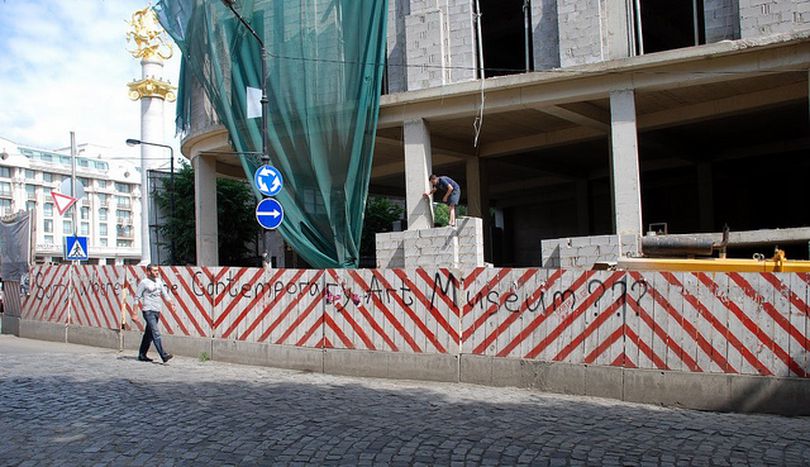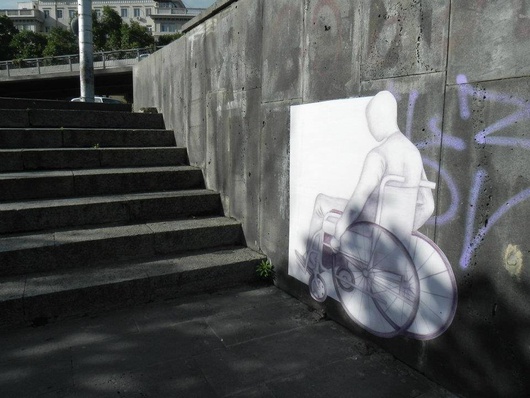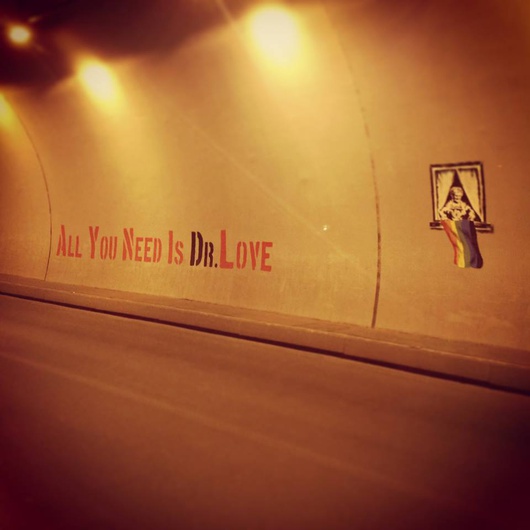
Contemporary art in Georgia
Published on
The pulse of contemporary art in every city is measured by the number of galleries and their characteristics. Both space and ambiance contribute to forming an artist. Therefore, it is important to inquire into all of the public/private spaces where an artist can perform and exhibit his or her art in Tbilisi.
In a country of 4.5 million inhabitants of which 1.5 million live in the capital, it often seems there is a lack of space for artists. But the problem is not a lack of space at all. The real trouble lies in the widespread belief that “everything happens in Tbilisi”. Due to this belief, artists from Batumi, Zugdidi or Kutaisi are moving to Tbilisi en masse and transforming their art and their lifestyles in search of new muses and financial support.
Space as a defining factor
 Some of the most prominent galleries which welcome contemporary artists are: Baia, Gala, Shardeni, Vache, Vernisage, Academy Hall and Kamea. But while we can cherish those spaces, there is no museum of contemporary art in Georgia. Yes, we do have the newly opened MoMa in Tbilisi , but this is a personal exhibition hall for Zurab Tsereteli’s artwork alone. Other than that, Georgian contemporary artists can boast about the Center for Contemporary Art-Tbilisi on D. Abashidze Street. The Center for Contemporary Art is a highly functional, independent regional hub for artists, students and researchers –redefining and exploring the art of the Soviet era that was repressed during that time. There is also an Artisterium- an annual contemporary arts festival in Tbilisi that is held with the support of the Ministry of Culture. But the list ends there and now artists are moving into the streets.
Some of the most prominent galleries which welcome contemporary artists are: Baia, Gala, Shardeni, Vache, Vernisage, Academy Hall and Kamea. But while we can cherish those spaces, there is no museum of contemporary art in Georgia. Yes, we do have the newly opened MoMa in Tbilisi , but this is a personal exhibition hall for Zurab Tsereteli’s artwork alone. Other than that, Georgian contemporary artists can boast about the Center for Contemporary Art-Tbilisi on D. Abashidze Street. The Center for Contemporary Art is a highly functional, independent regional hub for artists, students and researchers –redefining and exploring the art of the Soviet era that was repressed during that time. There is also an Artisterium- an annual contemporary arts festival in Tbilisi that is held with the support of the Ministry of Culture. But the list ends there and now artists are moving into the streets.
Spaces define artists and vice versa, as art reflects reality as it is. Whether we like their art or not, the raw reality by which we are nourished is overwhelmingly present there. In Georgia, as in typical post-soviet society, everyday life is full of politics and religion - two things which were privatized after the collapse of the Soviet Union. In such a state there is an imminent need for contemporary art to awaken society and give it a mirror in which to see its reflection. Most artists blame the government for not financing enough art projects. Meanwhile, private initiatives are so rare that the huge lack of investment in the arts cannot be explained only by the country’s economic difficulties. One just simply waits for the invisible hand to act instead of doing what is necessary to build a museum of contemporary art. Georgia has some pearls to show visitors from both the region and from around the world, and so we need such a museum.
Radical contemporary artists in Georgia
Radical is the word most often used in Georgian politics, but because our reality is so full of politics there is no space for anything else that is radical. Occasionally we see performances, but they are few and nonsystematic. Nonetheless, this section will attempt to enumerate the variety of radical artists currently working in Georgia.
 When speaking about contemporary art we must always mention the Tbilisi State Academy of Arts and its offspring - the new generation of artists who are creating their own wave of contemporary art in Georgia. This movement gave birth to the most impressive performance of today, which was the graduation project of a group of university students in late 2007. The performance was supposed to be held in the state art gallery, which would have made it even more impressive, but due to some difficulties they were forced to move to the children’s art gallery. Imagine a circle of seven people, sitting upright with neat white shirts, perfectly calm and in an organized manner, spitting at each other. This was protest merging with art. It was culture being used to oppose the violence of a closed society. As they expected, however, reactions to the performance were mostly negative. It seems that very few people really understood the true meaning of this performance.
When speaking about contemporary art we must always mention the Tbilisi State Academy of Arts and its offspring - the new generation of artists who are creating their own wave of contemporary art in Georgia. This movement gave birth to the most impressive performance of today, which was the graduation project of a group of university students in late 2007. The performance was supposed to be held in the state art gallery, which would have made it even more impressive, but due to some difficulties they were forced to move to the children’s art gallery. Imagine a circle of seven people, sitting upright with neat white shirts, perfectly calm and in an organized manner, spitting at each other. This was protest merging with art. It was culture being used to oppose the violence of a closed society. As they expected, however, reactions to the performance were mostly negative. It seems that very few people really understood the true meaning of this performance.
 Zaza Burchuladze, the acclaimed Georgian author, is the next in line to be called a radical, alternative artist. Whether it is the presentation of his new book or just another public appearance, he always startles the spectator through his narratives and actions. “Instant Kafka”, “Adibas”, “Conformist Essays”, “Mineral Jazz” and “Inflatable Angel” are symbols of postmodern literature in Georgia. The author touches upon tabooed themes such as sexuality, conformism, war and violence. As a reviewer once said, in ZaZa’s texts there are hidden bombs and there is a high probability that you will blow yourself up with them.
Zaza Burchuladze, the acclaimed Georgian author, is the next in line to be called a radical, alternative artist. Whether it is the presentation of his new book or just another public appearance, he always startles the spectator through his narratives and actions. “Instant Kafka”, “Adibas”, “Conformist Essays”, “Mineral Jazz” and “Inflatable Angel” are symbols of postmodern literature in Georgia. The author touches upon tabooed themes such as sexuality, conformism, war and violence. As a reviewer once said, in ZaZa’s texts there are hidden bombs and there is a high probability that you will blow yourself up with them.
Guram Tsibakhashvili is the most active and prominent photographer in Georgia. With his latest project called “IX-Block” a.k.a “Meckhre Bloki/მეცხრე ბლოკი” he represents moments of Georgian history in the 1990s. This time was characterized by a lack of electricity, food and a functioning state, but things were happening. His energy power station with the number nine was a mythical thing, as illusory as the whole reality of the early 90s.
 Outsider is a band formed in Kutaisi in 1989 by Robi Kukhianidze. This group belongs to the punk rock/ alternative genre. They held their most successful concert in 1999 called “Live in Kutaisi”. In 2000 the band moved from Kutaisi to the capital, where they began performing in small bars for a small audience. Outsider’s music is always present when a protest against the establishment is planned, and their existence is an inspiration to younger generations.
Outsider is a band formed in Kutaisi in 1989 by Robi Kukhianidze. This group belongs to the punk rock/ alternative genre. They held their most successful concert in 1999 called “Live in Kutaisi”. In 2000 the band moved from Kutaisi to the capital, where they began performing in small bars for a small audience. Outsider’s music is always present when a protest against the establishment is planned, and their existence is an inspiration to younger generations.
'Dzudzu' by Georgian punk-rock group 'Outisder'
The street is an alternative space for artists to present their work and to speak up. Street art in Georgia is increasingly important today, as it calls attention to social, political and gender issues.






